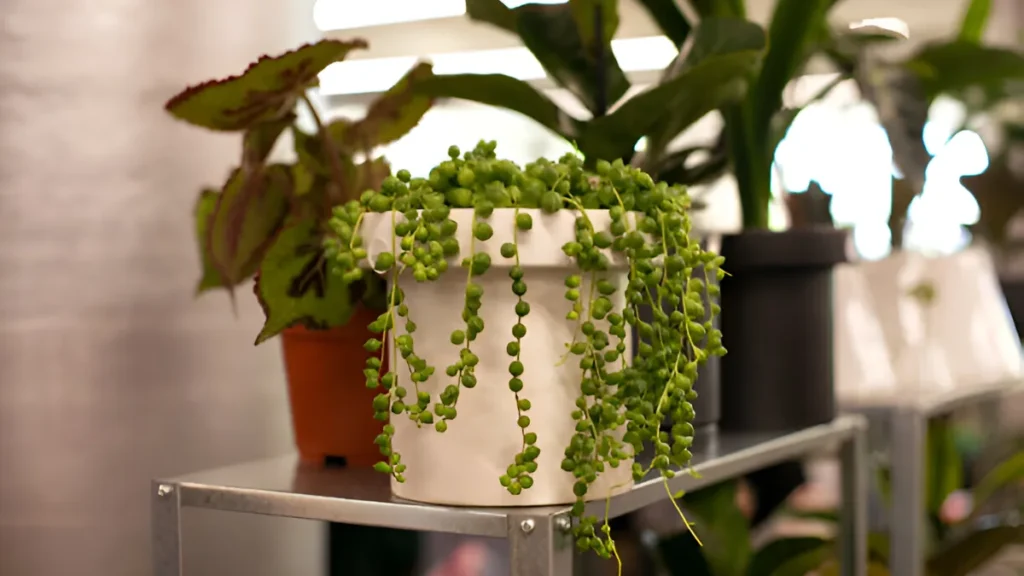The string of pearls plant (Curio rowleyanus) is a wonderful illustration of the diversity and variety seen in the world of succulents. The plant, often called string of beads, looks just like its namesake. Unique leaf structures that resemble peas adorn cascading stems, evoking the image of a delicate string of pearls. You’ve come to the perfect location whether you’re a novice wishing to add a distinctive plant to your collection or an experienced succulent fan. We’ll cover all you need to know in this guide to take care of and grow string of pearls (Senecio rowleyanus), an eye-catching succulent with trailing stems decorated with leaves that resemble beads.
String of pearls plant care:
Light
This string of beads, which belongs to the aster family, was discovered growing wild in South Africa’s eastern Cape. In its natural habitat, the plant grows in bright, sunny spots. String of pearls are a great houseplant that do best in bright, indirect sunshine. Especially during the hottest times of the day, place them close to a window so they may get sufficient of light without being directly exposed to the sun. A plant that receives insufficient light may grow lanky and lose its distinctive shape.
Water
Although String of Pearls is a drought-tolerant succulent, over watering can cause root rot. In between waterings, let the soil almost fully dry out. During the growing season (spring and summer), water sparingly, usually once every two to three weeks, and even less frequently during the dormant season (autumn and winter). To keep the fragile pearls from decaying, irrigate the soil directly rather than above.
Temperature
Temperatures between 70 and 80 degrees Fahrenheit (21-27 degrees Celsius) are optimal for growth. This plant does not withstand freezing temperatures and is hardy in zones 9 through 11 of the US Department of Agriculture’s hardiness map. In winter dormancy, the plant can tolerate temperatures as low as 50°F (10°C).
Soil
The soil around a string of pearls plant needs to drain extremely well. Choose a succulent potting mix or a well-draining cactus for your indoor plant. Sand or perlite can also be added to enhance drainage. Steer clear of dense, water-retaining soils since they may cause root rot.
Fertilizer
During the growing season, which spans the spring and summer, feed String of Pearls approximately once a month with a diluted, balanced liquid fertilizer. Don’t fertilize when the plant is dormant.
Pruning
As part of the upkeep of your string of pearls, you can occasionally discover that pruning plants is required to keep its size or attractiveness. It’s easy to accomplish this. Cut off any pearls that have fallen off the stems and any stems that have lost a significant amount of beads. Plants that are fuller and more compact will benefit from pruning back.
Pests and Diseases
Although overwatering can cause fungal problems and root rot, String of Pearls are comparatively resistant to pests and illnesses. Look out for symptoms of overwatering, such as burnt roots or mushy stems. These plants can also occasionally become infested by mealybugs and aphids; treat infestations as soon as possible with neem oil or insecticidal soap.
Conclusion:
As we get to the end of our comprehensive guide to string of pearl plants, it is clear that these unusual succulents have low care needs and visual appeal. Fans may grow healthy specimens indoors or out by knowing their particular requirements for light, water, soil, and temperature. These lovely plants may beautify living areas with their cascading strands of spherical leaves, giving a touch of whimsy and beauty to any atmosphere with a little patience, care, and nurturing.
Certainly! If you’d like to learn more, please consider following our WhatsApp Channel: Harvest Gardening
A frequently asked questions:
Q1: What is a string of pearls plant?
A1: Senecio rowleyanus, commonly known as the string of pearls plant, is a succulent plant distinguished by its trailing branches that are covered in spherical, pearl-like leaves.
Q2: Can I propagate my string of pearls plant?
A2: Yes, a string of pearls plant is readily propagated by taking stem cuttings and letting them callus for a few days before planting them in a soil that drains properly. To encourage root development, make sure the cuttings are exposed to oblique sunlight and give them occasional mists.
Q3: How can I encourage my blue string of pearls plant to grow and trail?
A3: Enough sunlight, sporadic fertilization during the growing season, and frequent pruning to stimulate branching are all necessary to encourage growth and trailing. To promote trailing growth, you can also gently guide the stems along a support structure.

